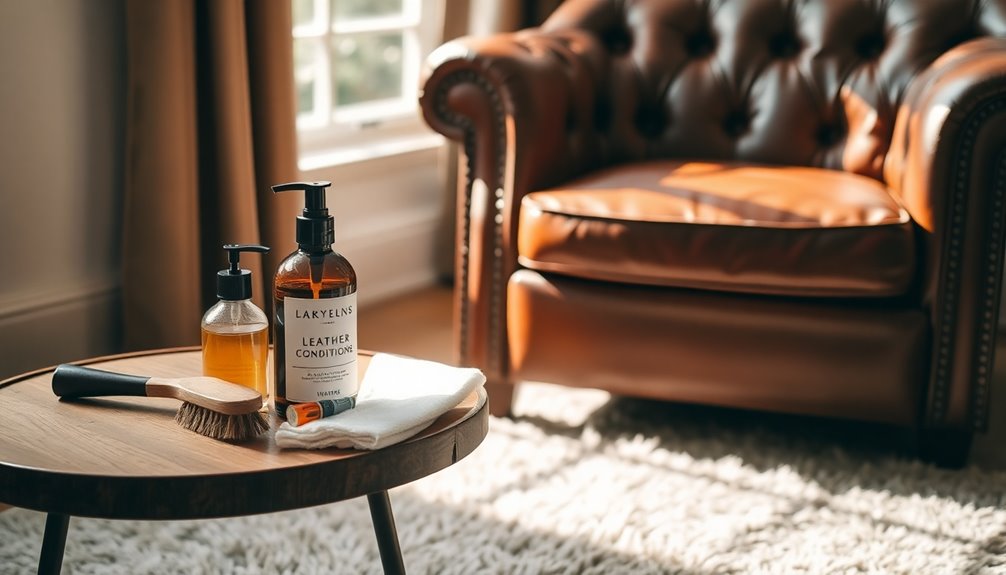To keep your leather looking elegant, start with daily maintenance by wiping it down with a soft cloth to remove dust. When spills occur, blot them immediately with a damp cloth. Regular conditioning every 6-12 months is key—use a conditioner with seed oils and beeswax, applied with a lint-free cloth. For deeper cleaning, lightly dampen a cloth, avoiding soaking. Protect your leather from direct sunlight and moisture by storing it in breathable covers. Remember to check for any damage and address it quickly. Follow these tips, and you might just uncover even more ways to care for your leather items.
Key Takeaways
- Regularly wipe leather with a soft, dry cloth to remove dust and dirt, maintaining its elegance.
- Act quickly on spills by blotting with a damp cloth to prevent stains from setting.
- Use a conditioner with seed oils and beeswax every 6-12 months to keep leather soft and supple.
- Apply high-quality waterproofing spray each season to protect leather from moisture and elements.
- Store leather items in breathable covers, avoiding plastic to prevent mold and deterioration.
Understanding Leather Types
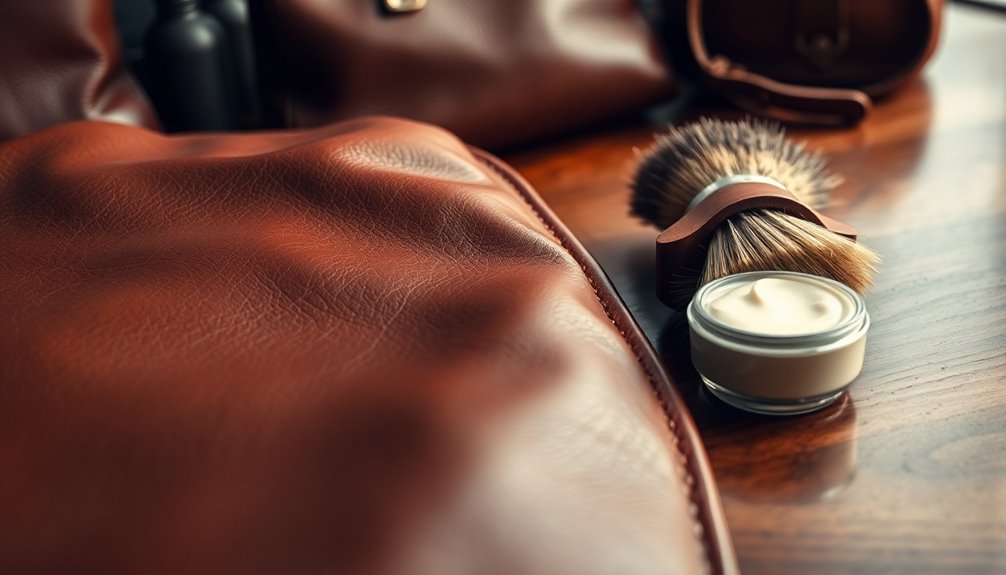
When you immerse yourself in the world of leather, it's essential to understand the different types available, as each offers unique qualities suited for various uses.
Full-grain leather stands out as the highest quality option, showcasing natural imperfections and incredible durability, making it perfect for premium items.
On the other hand, corrected grain leather provides a more affordable choice, as it's sanded to eliminate flaws while still remaining sturdy.
Nappa leather is another option, renowned for its soft and smooth texture, frequently found in luxury goods and garments.
Other types, like suede and split leather, offer budget-friendly alternatives but may lack in durability, making them better suited for less demanding applications.
Understanding these types helps you choose wisely.
Daily Care Practices

To keep your leather items looking their best, incorporate daily care practices into your routine.
Regularly wipe your leather products with a soft cloth to clean leather and remove dust and dirt. This simple step prevents buildup that can cause damage over time.
If moisture gets on your leather, blot it immediately with a gentle cloth and let it air dry away from direct heat sources.
Store your leather in breathable covers or dust bags; avoid plastic, as it can trap moisture and lead to mold.
Frequent use helps maintain flexibility, so don't let your items sit idle for too long.
Finally, protect your leather from direct sunlight and heat to prevent fading and drying. Keeping your leather clean and well-maintained also supports a healthier lifestyle by promoting cleanliness and hygiene.
Follow these leather care tips for lasting elegance.
Cleaning Techniques
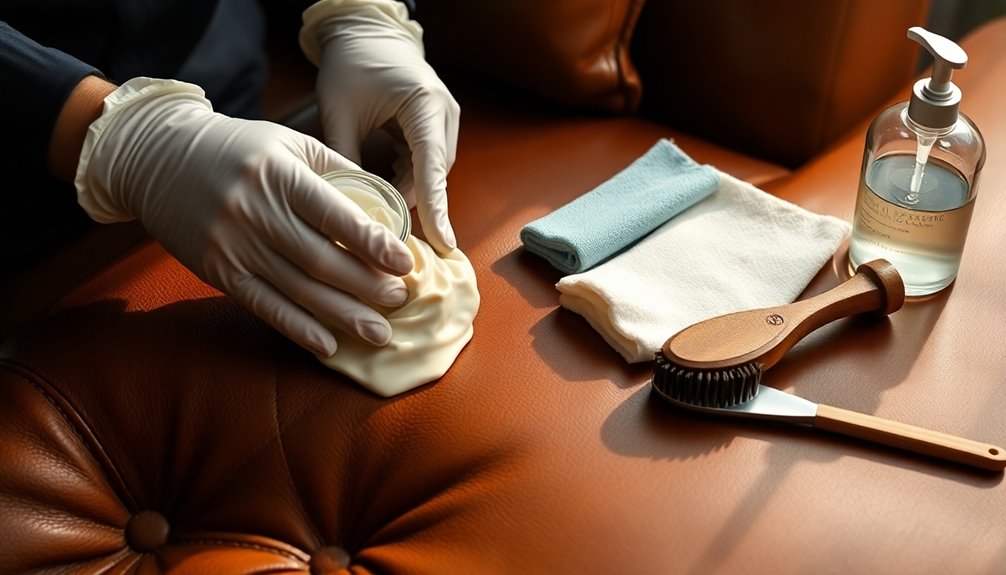
To keep your leather looking its best, regularly wipe it down with a soft, dry cloth to remove dust.
For any spills, act quickly by blotting the area with a damp cloth to prevent stains from setting in.
These simple techniques can help maintain your leather's beauty and longevity.
Regular Dust Removal
Keeping your leather surfaces clean is essential for preserving their beauty and longevity, and regular dust removal is a crucial first step.
To maintain your leather's elegance, follow these simple tips:
- Use a soft dry cloth or a premium shoe brush to gently remove dust.
- Aim to dust at least once a week to prevent dirt buildup.
- Always clean in the direction of the grain to protect the leather's texture.
- For deeper cleaning, lightly dampen the cloth with warm water—don't soak it!
Spot Cleaning Techniques
Spot cleaning leather can be a straightforward process if you know the right techniques. For light stains, gently blot the area with a soft, damp cloth instead of rubbing it, as rubbing can push the stain deeper.
If you're dealing with tougher stains like ink, quickly blot with a cotton ball or rag, and consider using baking soda or Castile soap to absorb the stain. Always test any cleaning solution on a hidden area first to avoid discoloration.
Remember to avoid using harsh chemicals, solvents, or abrasive cleaners, as these can ruin the leather finish.
Regularly inspect your leather items for spots and clean them immediately to maintain their elegant appearance and prevent permanent staining.
Conditioning Leather
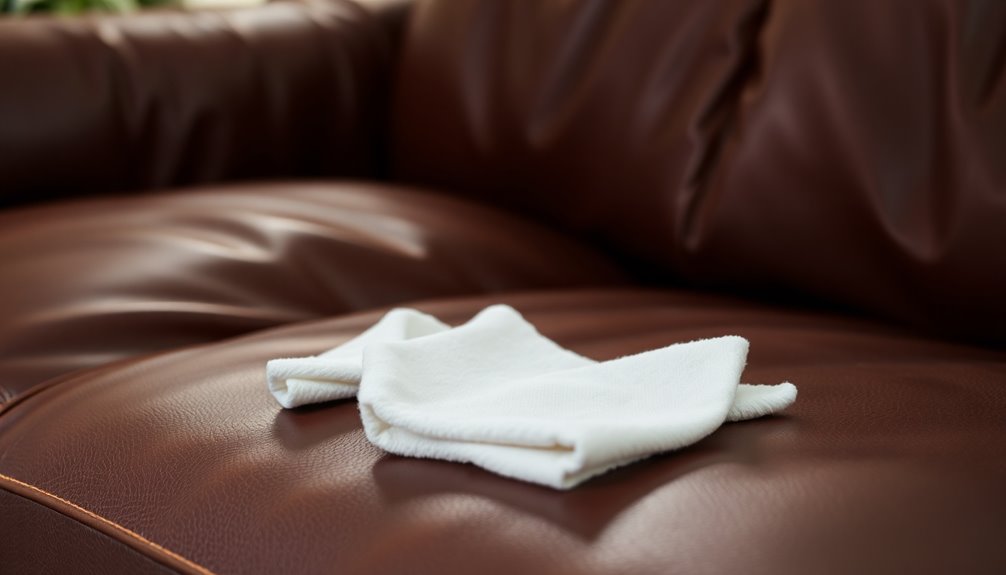
While leather is a durable material, it still needs regular conditioning to maintain its softness and prevent drying or cracking. Aim to condition every 6 to 12 months using high-quality leather conditioners.
Here's how to effectively condition your leather products:
- Choose a conditioner that contains seed oils and beeswax for nourishment.
- Apply with a clean, lint-free cloth, using circular motions.
- Allow it to dry for at least two hours or overnight.
- Buff off any excess to reveal the restored texture. Additionally, using essential oils like lavender oil can help maintain the leather's aroma while providing anti-inflammatory benefits.
Stain Removal Tips

When it comes to removing stains from leather, addressing spills immediately is key.
Use gentle cleaning techniques, and always test any solutions on a small area first.
For specialized stains, consider targeted methods to guarantee your leather stays in top condition.
Immediate Spill Response
Addressing spills on leather quickly can make all the difference in preventing permanent stains.
Here's how to execute an immediate spill response effectively:
- Blot the spill: Use a lightly damp soft cloth to absorb moisture without rubbing, which can spread the stain.
- Prepare a cleaning solution: For tough stains, mix a mild dish soap with water and apply it gently with a soft cloth.
- Test first: Always test any cleaning solution on a small, inconspicuous area before applying it directly to the stain.
- Act fast for ink: Blot ink stains immediately with a cotton ball, then use baking soda or Castile soap to lift the stain without pushing it deeper.
Following these steps helps in cleaning to remove stains effectively.
Gentle Cleaning Techniques
After you've handled any spills promptly, maintaining the cleanliness of your leather items is important for their longevity. Start with gentle cleaning techniques using a soft cloth to wipe away dust and dirt. For surface stains, mix mild soap with warm water on a damp cloth, applying gently and testing on a hidden area first. If you encounter ink stains, quickly blot with a cotton ball and consider using baking soda to absorb the ink.
| Task | Method |
|---|---|
| Dusting | Soft, dry cloth |
| Surface stains removal | Mild soap and warm water |
| Ink stain treatment | Baking soda or Castile soap |
Always avoid harsh chemicals to protect your leather's finish. Let wet leather dry naturally, away from heat.
Specialized Stain Solutions
Stains on leather can be a real headache, but tackling them quickly makes all the difference. Here are some specialized stain solutions to keep your leather looking great:
- Blot spills immediately with a lightly damp cloth to prevent stains from setting in.
- For ink stains, gently blot the area with a cotton ball or rag, and apply baking soda or Castile soap to absorb the ink.
- For grease stains, avoid water; instead, use baking soda to absorb the oil or consult a professional.
- To remove road salt, clean with a mild solution and saddle soap to eliminate residues and prevent water rings.
Always test cleaning methods on an inconspicuous area first to guarantee your leather remains in top condition. Additionally, keeping your leather well-maintained can help prevent potential damage that may result from neglecting proper care.
Protection From Elements
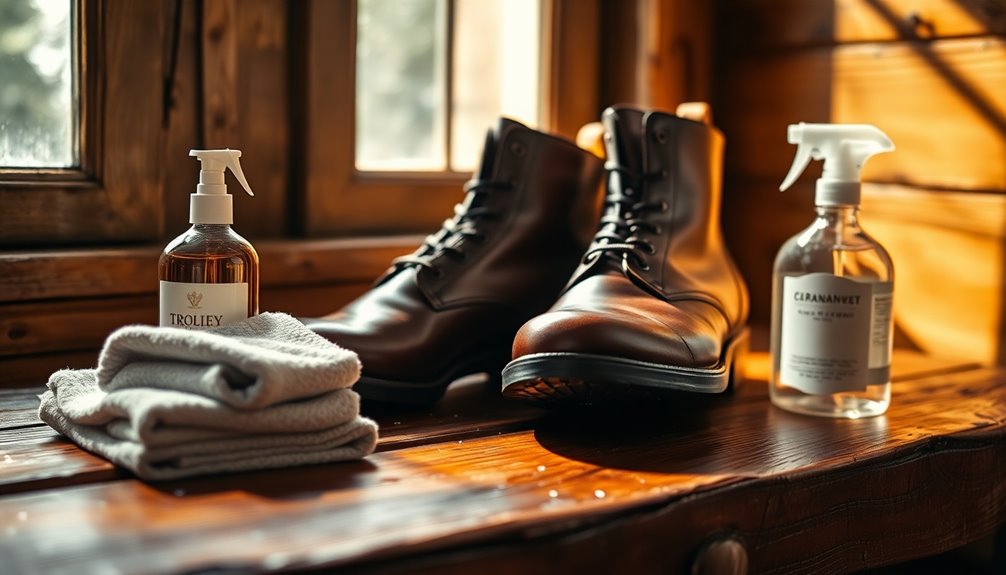
To keep your leather looking its best, protecting it from the elements is essential. Start by applying a high-quality waterproofing spray each season to shield your leather items from moisture, rain, and spills. Additionally, avoid direct sunlight to prevent fading and deterioration. Keep leather at least two feet away from heat sources like heaters to avoid drying out and cracking. Use breathable dust bags for storage to keep dust at bay, steering clear of plastic, which can trap moisture and promote mold. Regularly inspect your leather goods for any signs of wear, so you can take timely protective measures.
| Element | Protection Tip |
|---|---|
| Moisture | Use waterproofing spray seasonally |
| Sunlight | Keep out of direct sunlight |
| Heat Sources | Maintain distance from heaters |
Repairing Leather Damage
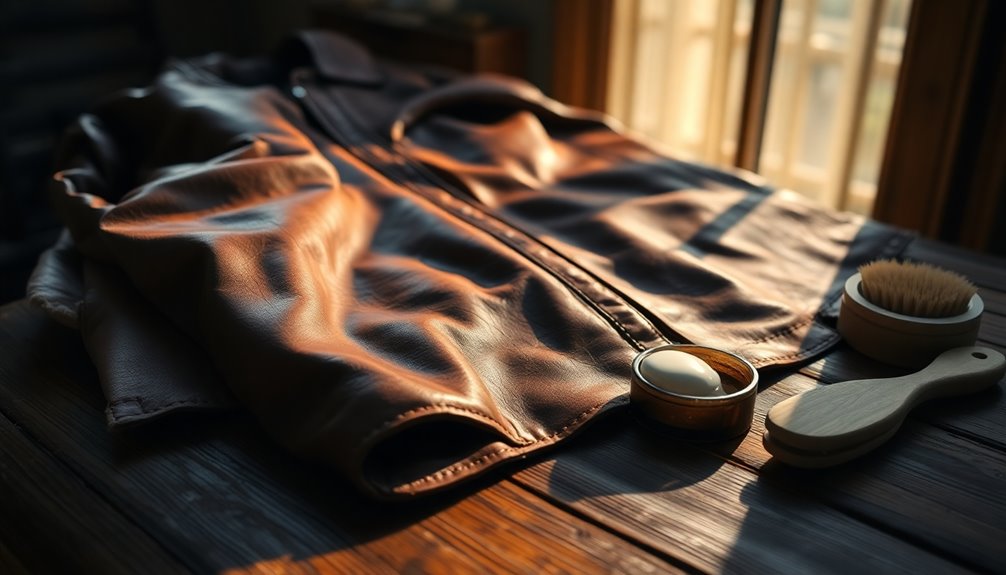
While leather is durable, it can still suffer from scratches, tears, and stains that require timely attention.
Here's how to effectively handle repairing leather damage:
- Buff Small Scratches: Use a soft cloth to gently buff out minor scratches.
- Use a Repair Kit: For deeper scratches, apply a leather repair kit that matches your leather's color.
- Address Stains Promptly: Blot ink stains with a cotton ball and use baking soda or Castile soap to remove surface marks.
- Seek Professional Help: For significant tears or color mismatches, consult a professional repair service.
Regularly applying a high-quality leather conditioner can also prevent cracks and maintain your leather's elegance.
Taking these steps guarantees your leather stays beautiful for years to come.
Frequently Asked Questions
What Do Professionals Use to Clean Leather?
Professionals use pH-balanced leather cleaners to guarantee they clean effectively without harming the leather's finish.
You'll notice they often grab microfiber cloths, which lift dirt gently without scratching the surface.
For deeper cleaning, they might use steam cleaners to sanitize without adding too much moisture.
After cleaning, they apply leather conditioners rich in natural oils to restore moisture and maintain suppleness, guaranteeing your leather looks its best for years to come.
What Do Professional Detailers Use to Clean Leather Seats?
Professional detailers use a variety of specialized tools to clean leather seats effectively.
They often rely on pH-balanced leather cleaners that remove dirt without harming the leather's natural oils. You'll notice they use microfiber cloths to gently trap dust and debris without scratching.
After cleaning, they apply high-quality conditioners and protectants to nourish the leather and create a barrier against stains, ensuring your seats stay looking great for longer.
How Do You Clean Leather Without Ruining It?
To clean leather without ruining it, start with a soft, dry cloth to dust off any dirt.
Mix mild soap with warm water or use a dedicated leather cleaner. Apply this solution gently using a lint-free cloth, avoiding excess moisture. Allow the leather to air dry away from direct sunlight or heat sources to prevent any damage. If you notice any stubborn stains, consider repeating the process a couple of times for the best results. For other materials, such as metal, you may want to explore the best methods for cleaning brass to ensure a polished finish without causing any harm.
Always test any product on a hidden area first. For stubborn stains, blot them with a damp cloth instead of rubbing, which could push the stain deeper into the leather.
Can I Use Dawn Dish Soap on Leather?
You might find it surprising, but yes, you can use Dawn dish soap on leather.
Just remember, it needs to be diluted with water to avoid damaging the material. Always perform a spot test first to check for discoloration.
Use a soft, lint-free cloth with a small amount of the diluted soap to gently clean.
Afterward, don't forget to condition the leather to keep it supple and prevent drying.
Avoid over-cleaning, too!
Conclusion
Caring for your leather is like nurturing a timeless relationship; with attention and love, it flourishes. By understanding its unique needs and practicing daily care, you keep its elegance alive, just like a cherished memory that grows brighter with time. Every cleaning and conditioning session is a gentle reminder of the beauty in preservation. So, embrace these tips and watch your leather transform, reflecting the enduring bond between you and a piece that tells a story.
